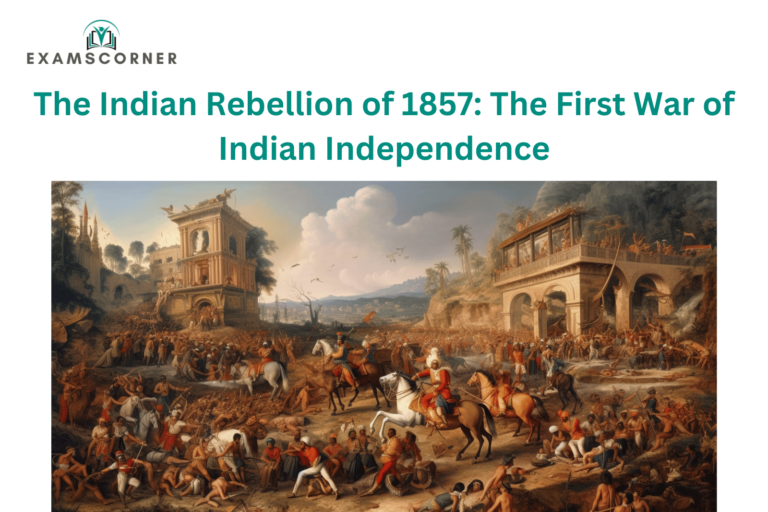The Indian Rebellion of 1857, often referred to as the First War of Indian Independence or the Sepoy Mutiny, marked the first large-scale and organized uprising against British rule in India. While it was ultimately unsuccessful, the rebellion left a lasting impact on the Indian people and fundamentally changed British governance over the subcontinent.
10 May 1857: The First War of Indian Independence
Origins of the Revolt
The rebellion began on May 10, 1857, in Meerut, sparked by deep-seated resentment towards the East India Company’s policies and governance. Although the East India Company controlled nearly two-thirds of the country, the remaining princely states, though nominally independent, had lost their sovereignty to the British through treaties and policies such as the Doctrine of Lapse. This atmosphere of discontent created fertile ground for rebellion.
Causes of the Revolt of 1857
1. Political Factors
- The Doctrine of Lapse, introduced by Lord Dalhousie, annexed princely states without a male heir. This deprived legitimate rulers of their kingdoms, fostering widespread resentment.
- Indian rulers were left powerless, and the sovereignty of native states was consistently undermined.
2. Economic Factors
- The colonial administration disrupted traditional agriculture and commerce, displacing countless individuals from their livelihoods.
- High taxes and exploitative policies burdened peasants, traders, and landlords.
3. Social and Cultural Factors
- The rapid pace of westernization created anxiety among Indians. British reforms, such as the abolition of Sati and widow remarriage laws, were perceived as an affront to traditional practices.
- There was growing fear of religious conversion to Christianity.
4. Military Factors
- Discrimination between Indian and British soldiers in pay, promotions, and privileges created deep-seated grievances.
- The introduction of the Enfield rifle acted as the immediate trigger. Rumors that the rifle cartridges were greased with cow and pig fat offended both Hindu and Muslim religious sentiments.
Immediate Causes of the Revolt
The rebellion was ignited by the actions of Mangal Pandey, a sepoy in the 34th Bengal Native Infantry.
- March 29, 1857: Pandey rebelled against his British commanders and fired at an officer. He was captured, court-martialed, and hanged, sparking outrage among Indian soldiers.
- April 24, 1857: At Meerut, 85 sepoys refused to use the Enfield rifles and were court-martialed. They were sentenced to 10 years of imprisonment and publicly humiliated on May 9, 1857.
- May 10, 1857: Outraged soldiers mutinied, freed their comrades, and killed British officers.
The Spread of the Rebellion
The rebellion rapidly spread to other parts of northern India:
- Delhi: On May 11, mutineers reached Delhi, capturing the city and declaring Mughal Emperor Bahadur Shah Zafar the Emperor of Hindustan.
- Kanpur, Lucknow, Jhansi, Gwalior, and Bihar: The revolt gained momentum as prominent leaders joined:
- Rani Lakshmibai of Jhansi
- Tantya Tope
- Nana Saheb
- Kunwar Singh
Unity Among Indians
The revolt brought together people from various walks of life, including peasants, landlords, Hindus, Muslims, and traders. Despite religious and caste differences, there was unprecedented solidarity against British rule.
Failure of the Revolt
Despite its intensity, the rebellion ultimately failed.
Reasons for Failure:
- Lack of Leadership: The sepoys had no single, unified leader. Leadership was fragmented across different regions.
- Poor Planning: There was no coherent strategy to oust the British or govern post-rebellion.
- Limited Participation: The revolt was largely confined to northern India. Regions like the Bombay, Madras, and Bengal Presidencies remained unaffected.
- Sikh Neutrality: Sikh soldiers, who were crucial to British forces, did not join the rebellion.
- British Resources: The British had superior resources, better organization, and reinforcements from outside India.
Aftermath of the Rebellion
Suppression of the Revolt
The British suppressed the rebellion ruthlessly, taking nearly 18 months to fully regain control.
End of Company Rule
The rebellion marked the end of the East India Company’s rule in India. The Government of India Act 1858 transferred authority directly to the British Crown.
Policy Changes Post-Rebellion
- Administrative Reforms: The British restructured their governance, adopting more conciliatory policies toward Indian rulers.
- Military Reforms: The proportion of Indian soldiers in the British army was reduced.
- Queen Victoria’s Proclamation: In 1858, Queen Victoria promised equal rights to Indian subjects and respect for their traditions and religions.
Legacy of the Revolt of 1857
Although unsuccessful, the revolt was a significant step in India’s struggle for independence. It demonstrated the growing discontent with British rule and sowed the seeds of nationalism that would later culminate in India’s independence movement.
The rebellion remains a powerful symbol of unity and resistance against colonial oppression in Indian history.
This pivotal event is not only a testament to India’s enduring spirit but also a reminder of the sacrifices made in the journey towards independence.



